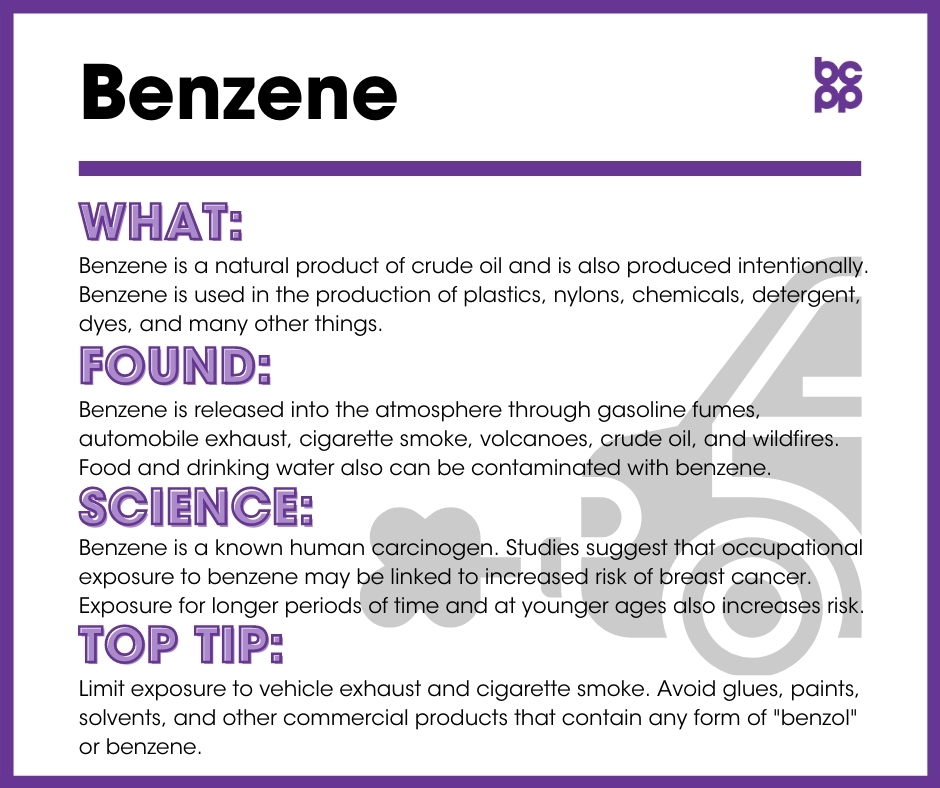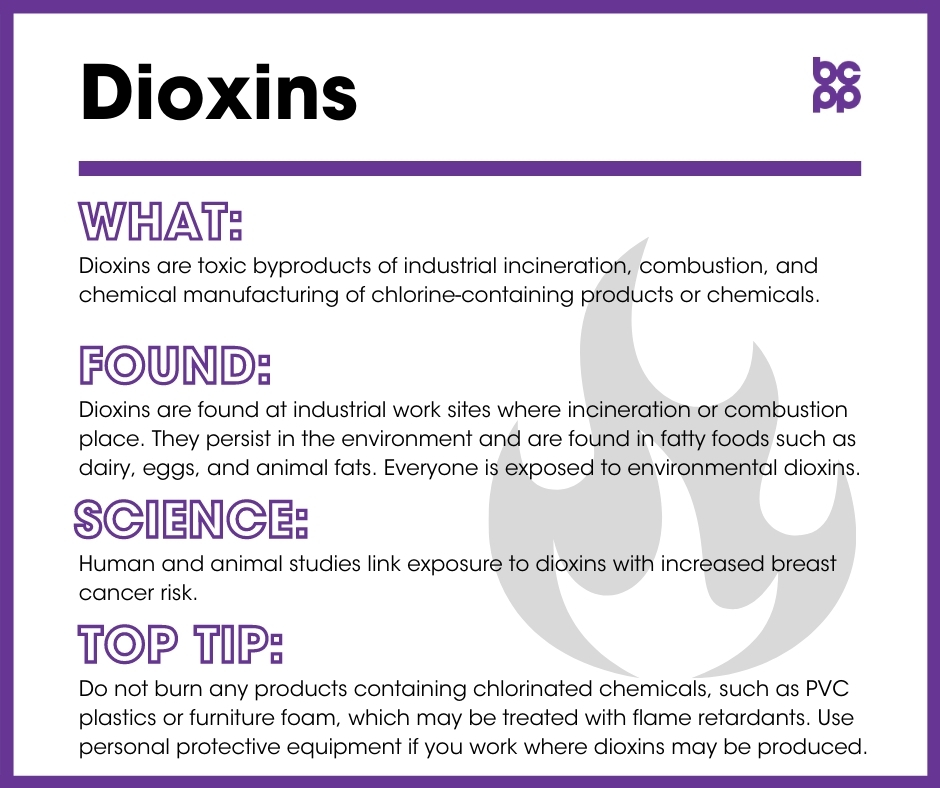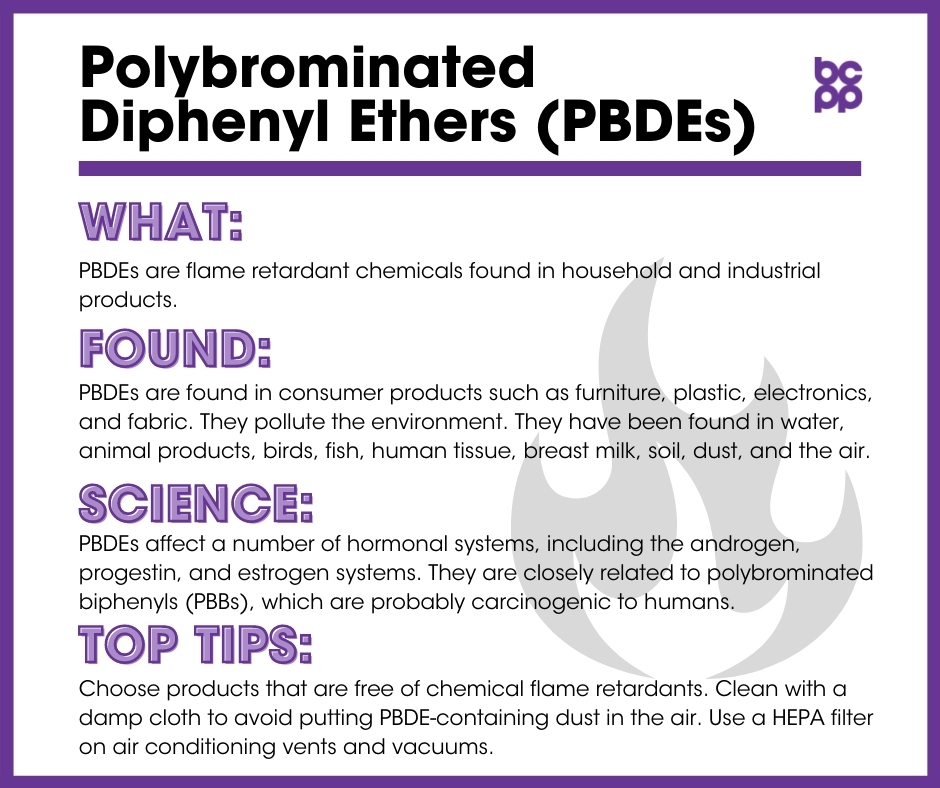Science & Policy
Glossary of Breast Cancer Exposures
When it comes to preventing breast cancer, did you know only 10% of breast cancers are attributed to genetics? Preventable causes of the disease include exposures to toxic chemicals and other environmental factors. We’ve summed up the science connecting the exposures with the strongest evidence linked to breast cancer for you here.
A
Air Pollution

Over the past few years, an explosion of scientific research has found that exposures to certain chemicals in polluted air are connected to breast cancer risk. Air pollution is a complex mix of toxicants that can vary in composition and have a wide range of harmful health effects.
Studies have consistently linked elevated levels of nitrogen oxide (NO2) – a substitute for measuring vehicle traffic emissions –to increased risk for developing breast cancer.
Alcohol

Alcohol consumption increases risk for breast cancer, as demonstrated by a large body of research.
The more one drinks, the higher the risk, and even light drinking increases risk. Research on interactions between alcohol consumption and other lifestyle and demographic factors reveals more complicated results.
Alkylphenols

Alkylphenols are a group of chemicals that are used in the manufacturing of detergents, cleaners, and other products.
They are found throughout our indoor and outdoor environments and disrupt the body’s hormone system.
Aromatic Amines

Aromatic amines are chemicals found in industrial and manufacturing plants, tobacco smoke, commercial hair dyes, and diesel exhaust.
Many are carcinogens and endocrine disruptors that may increase the risk of breast cancer.
Atrazine

Atrazine is an herbicide used in the United States to kill broadleaf and grassy weeds. It is primarily used in commercial agriculture, but can also be used to control weeds in residential lawns and on golf courses.
Atrazine is an endocrine disruptor, and exposure to atrazine has been associated with an increased risk of developing breast cancer.
B
Benzene

Benzene is one of the most widely produced chemicals in the world. Benzene is used in the production of other chemicals and is present in the atmosphere. It is a known human carcinogen.

Atrazine is an herbicide used in the United States to kill broadleaf and grassy weeds. It is primarily used in commercial agriculture, but can also be used to control weeds in residential lawns and on golf courses.
Atrazine is an endocrine disruptor, and exposure to atrazine has been associated with an increased risk of developing breast cancer.
Bioidentical hormones

Bioidentical hormones are compounds produced to be chemically and biologically the same as naturally occurring hormones such as estradiol and progesterone.
Their effect on breast cancer development is unclear, due to conflicting evidence.
BPA (Bisphenol-A, Bisphenols)

Bisphenols are endocrine-disrupting compounds and reproductive toxicants. Bisphenols such as BPA(Bisphenol-A), BPF, BPS, and BPAF are some of the most common chemicals we’re exposed to each day, and they are in everything from food and drink containers to dental fillings.
BPA can disrupt the hormone system, particularly when exposures occur during prenatal development and infancy.
Bovine Growth Hormone (rBGH & rBST)

Recombinant somatotropin, rBST (previously called bovine growth hormone), is a genetically engineered hormone injected into dairy cows to increase milk production. Milk from rBST-treated cows is used in dairy products including ice cream, butter, cheese and yogurt.
Though research is mixed on the extent to which dairy consumption is linked to increased cancer risk, higher blood levels of IGF-1 have been linked to increased risk for pre-menopausal breast cancer.
1,3-Butadiene

1,3-butadiene is a chemical processed from petroleum. It is most commonly used in the production of rubber.
1,3-butadiene has been listed as a human carcinogen by the National Toxicology Program and by the Environmental Protection Agency.
C
Cadmium

Cadmium is a metal that is most often used in batteries, coatings and plating, semi-conductors, and as a stabilizer for plastics.
Cadmium has been shown to demonstrate estrogen-like activity, which is known to increase breast cancer risk. Other metals such as nickel, chromium, zinc, lead and mercury have been shown to have similar estrogen-like effects.
Cadmium has been recognized as a human carcinogen by both the International Agency for Research on Cancer (IARC) and the National Toxicology Program.
Chlorpyrifos
Chlorpyrifos is a pesticide and insecticide widely found on produce and home pest control formulas that is an endocrine disruptor and breast carcinogen. Exposure to chronic low doses of chlorpyrifos leads to an increased risk of mammary tumors in lab studies.
Banned in the EU, California, New York, and Hawaii, several other U.S. states are considering a ban on chlorpyrifos.
To avoid consuming this pesticide, choose organic produce when possible and wash produce thoroughly. Also, wear synthetic protective clothing if you are exposed to this chemical in an agricultural or home setting.
D
Dichloro-diphenyl-trichloroethane (DDT)

Dichloro-diphenyl-trichloroethane (DDT) is a pesticide used in agriculture. The grave effects of DDT on animal reproduction and wildlife led to its ban in most, but not all, countries. Unfortunately, DDT does not degrade quickly, and it is still present in soil, plants and animal fats all over the world.
As a result of consumption of and exposure to these sources, it can be found in blood samples of a majority of people.
Dieldrin and aldrin

Aldrin and dieldrin are toxic pesticides now banned due to concerns about their impact on human health.
They have been linked to both an increased risk of breast cancer and higher rates of mortality from breast cancer.
Diethylstilbestrol (DES)

Diethylstilbestrol (DES), was prescribed to millions of pregnant women from 1938 to 1971 to help prevent pregnancy complications.
In the late 1960s, doctors realized that there was a strong association between in utero exposure to DES and the incidence of rare vaginal and cervical cancer in young women and girls. It was later discovered that exposure to DES was also associated with an increased risk of developing breast cancer. DES was banned in the United States in 1971.
Dioxins

Dioxins are toxic byproducts of industrial incineration, combustion and chemical manufacturing.
Dioxins have been linked to an increased risk of breast cancer.
E
Ethylene oxide (EtO)

Ethylene oxide (EtO), a known human carcinogen, is a colorless, flammable gas that is used to sterilize medical equipment and to make chemicals used in household and personal care products. During this process, traces of EtO are sometimes left behind.
During the 1980s, it is estimated that more than 270,000 U.S. workers were exposed to the chemical every year. The use of EtO has since decreased in the United States, though it is still used.
F
Fragrance

Fragrance or ‘parfum’ can consist of any of approximately 4,000 chemicals used by the fragrance industry to formulate scents for use in personal care products, cleaning products, perfumes, and home care products. Many fragrance chemicals are linked to cancer, birth defects, hormone disruption, and other chronic health problems.
G
Glyphosate
Glyphosate is a synthetic hormone-disrupting compound chemical widely used in herbicides, most notoriously in Monsanto’s Roundup. In fact, glyphosate-based herbicides (GBHs) are the most widely used herbicides globally.
Glyphosate exposures during critical periods of breast development (e.g., gestation, early childhood, adolescence, pregnancy) may lead to later risk for developing breast cancer.
H
Heavy Metals
Heavy metals such as cadmium, arsenic, and nickel are group I carcinogens and show associations with increased breast cancer risk.
Heptachlor

Heptachlor is an insecticide classified as a probable human carcinogen. It was banned in 1988 but still lingers in the environment. Exposure can occur through contaminated water, food, soil or air.
Hormone replacement therapy (HRT)

Hormone replacement therapy (HRT) often includes a combination of estrogen and progestin, prescribed to treat menopausal symptoms in women.
HRT is a known carcinogen recognized by the International Agency for Research on Cancer (IARC) that has been associated with an increased risk of breast cancer, heart disease, stroke and blood clots. The components of BiCs, estradiol and progesterone, have also been determined by IARC to be either known or reasonably anticipated carcinogens and associated with numerous negative health outcomes.
Hormones in personal care products

Hair care products, such as hair relaxers and hair dyes marketed to women of color, sometimes include placental extracts, which are likely to contain natural progesterone and estrogens. Estrogen may be added to some anti-aging creams for their effectiveness in raising collagen count and increasing skin hydration.
Hormones in personal care products are listed as a known carcinogen by the International Agency for Research on Cancer (IARC) and the National Toxicology Program (NTP).
I
Ionizing radiation

Ionizing radiation is any form of radiation with enough energy to alter an atom, such as X-rays or nuclear energy. Evidence from studies of medical exposures to radiation as well as large-scale disasters such as exposures from the atomic bomb in Japan has demonstrated that radiation can cause breast cancer.
The International Agency for Research on Cancer (IARC) and the National Toxicology Program (NTP) classify it as a known human carcinogen.
N
Night Shift Work and Light-at-night (LAN)

Light-at-night (LAN) is exposure to light during hours when it is normally dark. This exposure is common for evening and night shift workers, as well as for people living in urban areas where there is significant light pollution.
Exposure to light-at-night has been linked to an increased risk of developing breast cancer. Recent data suggest that exposure to smartphone and computer screens into the evening, before heading to sleep, may also be an important source of LAN.
Non-ionizing radiation

Microwaves, radio waves, fluorescent lighting, computers, cell phones, radar and radiation produced by electrical transmission are examples of non-ionizing radiation sources that generate varying strengths of electromagnetic fields (EMFs). Non-ionizing radiation is considered a possible human carcinogen, primarily due to concerns about childhood leukemia and brain tumors.
As of yet, there is no clear evidence linking breast cancer with non-ionizing radiation.
Oral contraceptives

Oral contraceptives, otherwise known as birth control pills, are among the most common medications used by women.
They have been classified as human carcinogens by the International Agency for Research on Cancer.
O
Organic solvents

Organic solvents are chemicals used in industries such as printing and manufacturing and found in consumer goods such as cleaning products and personal care products.
Exposure to these solvents may increase the risk of developing breast cancer.
P
Pesticides and herbicides

Pesticides and herbicides are used to control insects and unwanted plants in agricultural fields. The chemicals in pesticides and herbicides can be inhaled or absorbed through the skin by those who work or live in close vicinity to the fields. When chemical residues remain on or in produce, meat, or fish, we may also consume these harmful chemicals.
Exposure to the pesticides and herbicides below, especially during critical periods of breast development such as prenatally and in early childhood, is associated with an increased risk for developing breast cancer.
Parabens

Parabens are a group of chemicals that prevent the growth of mold, bacteria and yeasts. They are often added to cosmetics and personal care products to increase shelf-life and stability.
Parabens enter the body through dermal absorption, ingestion and inhalation, and can enhance the actions of the natural estrogen known as estradiol.
PFAS “Forever Chemicals”

PFAS “Forever Chemicals” (per- and poly-fluoroalkyl substances) are a family of synthetic chemicals that builds up in humans and is linked to numerous health problems including cancer. The two most widely detected PFAS, PFOA (perfluorooactanoic acid) and PFOS (perfluorooctanesulfonic acid), have been used extensively in products for their properties of high stability and low surface tension. PFOA and PFOS are found in items ranging from cookware and paper food packaging to personal care products, carpeting and firefighting foam, and provide stain resistance.
PFOA is a suspected endocrine (hormone) disruptor and possible carcinogen, and PFOS has been linked to fertility problems. Several PFAS chemicals, especially PFOA, have been linked to increased risk for breast cancer.
Phthalates

Phthalates are a group of chemicals used to soften and improve the flexibility and durability of plastics.
Phthalates are endocrine disruptors, and exposure to phthalates has been linked to breast cancer, developmental issues, decreased fertility, obesity and asthma.
Polybrominated Diphenyl Ethers (PBDEs)

PBDEs are a class of compounds used as flame retardants.
They are endocrine disrupting compounds associated primarily with thyroid disruption. Some evidence also links them to breast cancer.
Polychlorinated Biphenyls (PCBs)

PCBs are classified as a probable carcinogen by the International Agency for Research on Cancer (IARC) and a reasonably anticipated carcinogen by the National Toxicology Program (NTP). These chemicals have wide-ranging effects on the immune system, reproductive system, nervous system and endocrine system. Certain individual PCBs are linked to increased risk of breast cancer, while others are not because of the differing individual compounds’ effects on endocrine and other biological systems.
The EPA banned PCBs from new products in 1976. Due to their persistence in the environment, they are still found in soil, riverbeds and dust particulates in homes. They also remain in products manufactured prior to the ban such as paper, plastics and paints.
Polycyclic aromatic hydrocarbons (PAHs)
Polycyclic aromatic hydrocarbons (PAHs) are a group of more than 100 chemical compounds that are prevalent in the environment and food.
They contribute to indoor and outdoor air pollution and are harmful to humans.
S
Sunscreens (UV Filters)

Research has found that many (not all) sunscreens contain chemicals that mimic estrogen in the body, disrupt the endocrine system, and can play a significant role in breast cancer development.
T
Tobacco smoke

Tobacco smoke contains chemicals that have been linked to cancer, from both active and passive smoking.
The use of cigarettes has been linked to stroke, coronary heart disease, and many cancers, including lung cancer and breast cancer.
Triclosan

Triclosan is an antimicrobial agent added to a wide array of household products to prevent the growth of bacteria and fungus. It has been found in human blood, urine and breast milk.
The chemical is a potential endocrine disruptor in humans. It can also have negative impacts on environmental health, including aquatic systems.
V
Vinyl chloride

Vinyl chloride was a common ingredient used in cosmetic products, refrigerants and household aerosols in the United States. It is also used to make polyvinyl chloride (PVC), which is a repeating chain of vinyl chloride.
Vinyl chloride is synthetic and does not occur naturally.
Z
Zeranol and Mycoestrogens

Mycoestrogens are naturally occurring endocrine disruptors found primarily in grains. An important metabolite (breakdown product) of zearalenone is zeranol, a compound that is also produced as a synthetic compound (brand name Ralgro) and is largely used in the U.S. beef industry to increase growing speeds of the animals used for meat.
Certain mycoestrogens, including especially zearalenone, may advance the growth of breast cancer cells. Zearalenone and zeranol mimic the natural estrogen estradiol. Both compounds can stimulate growth and proliferation of human breast tumor cells in vitro at potencies similar to the effects of estradiol.
For more, see our full analysis of 23 factors that can influence breast cancer, which goes beyond exposures to include lifestyle factors like diet, exercise, and more.
What is an exposure?
We often come into contact with—or are exposed to—substances and other factors linked to breast cancer. These include chemicals as well as physical agents such as ionizing radiation and light-at-night. This glossary highlights certain exposures with the strongest evidence linked to breast cancer. For each, we describe what it is, where it’s found, the science linking it to breast cancer, who is most vulnerable and how to avoid the exposure.
Exposures we are monitoring
These are exposures that we frequently get questions about. Although we don’t consider them to be exposures of concern at this time, we continue to monitor the relevant emerging scientific evidence.
Infertility treatment drugs
No clear link has been established between infertility treatments overall and breast cancer risk. A recent study did show an increase in breast cancer risk for women who started infertility drug treatments before the age of 24, and a link has been found for women treated with high doses of the infertility treatment drug clomiphene citrate.
Additional research should continue to examine the safety of infertility treatments, particularly for women who are BRCA positive.

